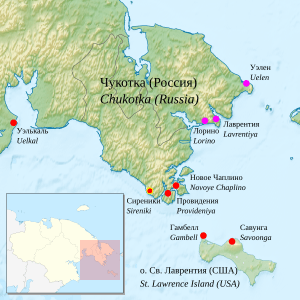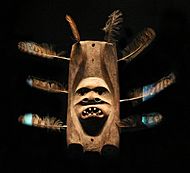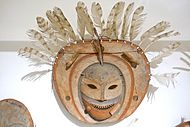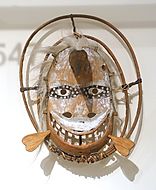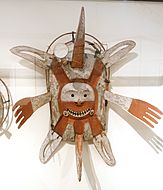Siberian Yupik facts for kids

A Siberian Yupik woman holding walrus tusks, photo by Nabogatova
|
|
| Total population | |
|---|---|
| 2,828 | |
| Regions with significant populations | |
| Chukotka in the Russian Far East, St. Lawrence Island in Alaska | |
| Russia | 1,728 |
| United States | 1,100 |
| Languages | |
| Siberian Yupik, Russian, English | |
| Related ethnic groups | |
| Alutiiq, Central Alaskan Yup'ik | |
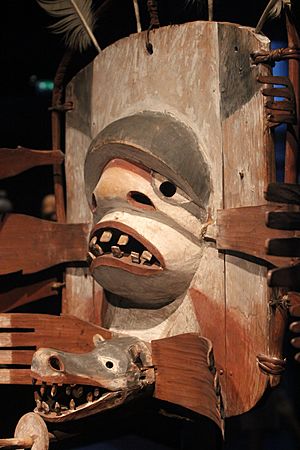
The Siberian Yupiks, also known as Yuits, are a group of Yupik people. They live along the coast of the Chukchi Peninsula in the far northeast of Russia. They also live on St. Lawrence Island in Alaska, United States.
They speak the Central Siberian Yupik language. This language is part of the larger Eskimo–Aleut language family. The name "Yuit" was officially given to them in 1931. However, they call themselves Yupighyt, which means "true people."
Another group, the Sirenik Eskimos, also live in this area. Their language, Sireniki Eskimo, is now extinct. It was very different from other Eskimo languages.
Contents
Siberian Yupik Culture and Traditions
Traditional Crafts and Art
Siberian Yupiks on St. Lawrence Island live in the villages of Savoonga and Gambell. They are famous for their amazing carvings. They use materials like walrus ivory, whale bone, and the baleen from bowhead whales.
Some of their carvings are even "moving sculptures." These sculptures use complex pulleys to show scenes like walrus hunting or traditional dances.
Traditional Homes
The winter homes of the Chaplino Eskimos (a Siberian Yupik group) were round, dome-shaped buildings. These homes are called yaranga, a word also used for similar buildings of the Chukchi people.
Inside the yaranga, there was a smaller cabin called an aaghragh. This inner room was used for sleeping and living. It was kept warm by using reindeer skins and grass. These materials were supported by a cage-like frame.
The front part of the yaranga was used for daily chores and storing household items. This area was called a natek. During winter storms and at night, dogs would also stay in this part of the home. Other types of homes included a more modern style and a lighter building used in summer.
Spiritual Beliefs
Shamans and Their Role
Many Indigenous cultures in Siberia had special people called "shamans." Shamans were believed to be mediators. This means they could communicate between humans and spirits or other beings.
Siberian Yupiks also had shamans. Their shamans focused a lot on keeping a good relationship with sea animals. The Ungazighmiit people, a large Siberian Yupik group, had shamans who received gifts for their healing work. These payments had a special name, akilisaq.
Protecting Against Illness
The Evan people, who lived in eastern Russia, had a unique belief about illness. They thought the spirit of smallpox looked like a Russian woman with red hair. A local shaman would meet migrating reindeer herders. Sometimes, these herders might unknowingly bring illness with them.
If the shaman saw the spirit of illness, several shamans would work together. They would perform a special ritual to try and fight it off. Other people in the tribe would help with this important ceremony.
It was believed that the illness spirit would change into a red bull when attacked. This spirit was thought to be very powerful. If the shamans' ritual failed, everyone in the area might die. Only two people would be spared to bury the others. But if the ritual worked, the spirit would be forced to leave.
Giving Names to Babies
For Siberian Yupiks, giving a name to a newborn baby was a very special event. It was believed that a deceased person was affected by this. It was like a kind of rebirth. Before a baby was born, people would carefully look for signs. They would analyze dreams and events.
After the birth, the baby's physical features were compared to those of the deceased person. The name was considered very important. If a baby died, it was thought that they had not been given the "right" name. If a child became sick, people hoped that giving them additional names could help them heal.
Protective Amulets
Amulets were objects believed to have special powers. They could protect a person or an entire family. There were also amulets specifically for hunting. Here are some examples:
- A raven's head hanging at the entrance of a house. This was believed to protect the family.
- Small figures carved from stone, shaped like a walrus head or a dog head. These were worn by individuals for protection.
- Hunting amulets were attached to tools or worn by hunters. For example, images of orcas were placed on marine hunting tools. This was because of special beliefs about these animals.
Animal World Beliefs
Animals like the orca, wolf, raven, spider, and whale were highly respected. Many stories and tales show this respect. For example, one story tells how a spider saves a girl's life. The idea of a spider helping people in danger is also found in many tales of the Sireniki Eskimos.
Siberian Yupiks believed that animals caught during a marine hunt could return to the sea. They thought these animals could become whole again. Because of this belief, they did not break the bones of hunted animals. They only cut them at the joints.
Orca and Wolf
In the stories and beliefs of the Siberian Yupik people, the wolf and the orca are seen as connected. It was thought that an orca could turn into a wolf, and a wolf could turn into an orca. In winter, they appeared as wolves. In summer, they appeared as orcas.
Orcas were believed to help people with sea hunting. Because of this, hunting boats often had images of orcas. Hunters would also wear small wooden orca figures on their belts. Small sacrifices, like throwing tobacco into the sea, were given to orcas. This was done to encourage them to help hunters find walruses.
It was also believed that the orca, even in the form of a wolf, helped hunters. This wolf was thought to guide reindeer towards hunters, making the hunt successful.
Whale Hunting and Respect
Siberian Yupiks believed that only people chosen by the spirit of the sea could successfully hunt a whale. After a whale was killed, the hunter had to treat it with great respect. The whale was seen as a special guest.
Just like a polite host would not leave a dear guest alone, the hunter who killed the whale would not leave it alone. The whale, as a guest, should not be hurt or feel sad. It had to be entertained with things like drum music and good foods.
When whales migrated again (which happens twice a year), the previously killed whale was sent back to the sea. This was done during a special farewell ritual. If the killed whale was pleased during its time as a guest, it was hoped that it would return later. This would ensure successful whale hunts in the future.
Sky and Stars
In some tales, the sky is imagined as a large, arched ceiling. The stars and other celestial bodies are seen as holes in this ceiling. Beyond this arched sky, there is believed to be a very bright and special space.
-
A Yup'ik mask from the 19th century, at the Musée du Quai Branly in Paris.
See also
 In Spanish: Yupik de Siberia para niños
In Spanish: Yupik de Siberia para niños
- Siberian Yupik language
- Yupik languages
- Yupik
- Eskimo
- Naukan people of the Chukchi Peninsula
- Eskimo yo-yo
- Whistled language



